|
|
|
Sort Order |
|
|
|
Items / Page
|
|
|
|
|
|
|
| Srl | Item |
| 1 |
ID:
090989
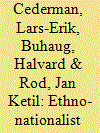

|
|
|
|
|
| Publication |
2009.
|
| Summary/Abstract |
Previous quantitative research on ethnic civil war relies on macro-level proxies in an attempt to specify the conditions under which ethnic minorities rebel. Going beyond an exclusive focus on minorities, the present study employs Geographic Information Systems (GIS) as a way to model ethnic center-periphery dyads that confront governments with excluded groups. We construct and analyze a new dataset of geo-referenced politically relevant ethnic groups, covering the entire world during the period from 1951 through 2005. Our results show that the conflict probability of marginalized groups increases with the demographic power balance compared to the group(s) in power. Furthermore, the risk of conflict increases with the distance from the group to the capital, and the roughness of the terrain in the group's settlement area. We also find that while the results for demographic group strength hold for all ethnic civil wars, the geographic factors apply for territorial ethnic conflicts only.
Previous quantitative research on ethnic civil war relies on macro-level proxies in an attempt to specify the conditions under which ethnic minorities rebel. Going beyond an exclusive focus on minorities, the present study employs Geographic Informat
|
|
|
|
|
|
|
|
|
|
|
|
|
|
|
|
| 2 |
ID:
126300
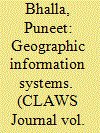

|
|
|
| 3 |
ID:
107048


|
|
|
|
|
| Publication |
2011.
|
| Summary/Abstract |
As terrorism on all scales continues, it is necessary to improve understanding of terrorist and insurgent activities. This article takes a Geographic Information Systems (GIS) approach to advance the understanding of spatial, social, political, and cultural triggers that influence terrorism incidents. Spatial, temporal, and spatiotemporal patterns of terrorist attacks are examined to improve knowledge about terrorist systems of training, planning, and actions. The results of this study aim to provide a foundation for understanding attack patterns and tactics in emerging havens as well as inform the creation and implementation of various counterterrorism measures.
|
|
|
|
|
|
|
|
|
|
|
|
|
|
|
|
| 4 |
ID:
149133
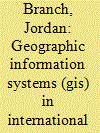

|
|
|
|
|
| Summary/Abstract |
Geographic Information Systems (GIS) are being applied with increasing frequency, and with increasing sophistication, in international relations and in political science more generally. Their benefits have been impressive: analyses that simply would not have been possible without GIS are now being completed, and the spatial component of international politics—long considered central but rarely incorporated analytically—has been given new emphasis. However, new methods face new challenges, and to apply GIS successfully, two specific issues need to be addressed: measurement validity and selection bias. Both relate to the challenge of conceptualizing nonspatial phenomena with the spatial tools of GIS. Significant measurement error can occur when the concepts that are coded as spatial variables are not, in fact, validly measured by the default data structure of GIS, and selection bias can arise when GIS systematically excludes certain types of units. Because these potential problems are hidden by the technical details of the method, GIS data sets and analyses can sometimes appear to overcome these challenges when, in fact, they fail to do so. Once these issues come to light, however, potential solutions become apparent—including some in existing applications in international relations and in other fields.
|
|
|
|
|
|
|
|
|
|
|
|
|
|
|
|
| 5 |
ID:
045999
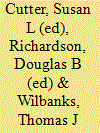

|
|
|
|
|
| Publication |
New York, Routledge, 2003.
|
| Description |
xxi, 274p.
|
| Standard Number |
0415946425
|
|
|
|
|
|
|
|
|
|
|
|
Copies: C:1/I:0,R:0,Q:0
Circulation
| Accession# | Call# | Current Location | Status | Policy | Location |
| 047008 | 363.32/GEO 047008 | Main | On Shelf | General | |
|
|
|
|
| 6 |
ID:
090992


|
|
|
|
|
| Publication |
2009.
|
| Summary/Abstract |
The literature suggests that geographically concentrated groups face a higher likelihood of conflict. While this finding seems to be commonly accepted, there is no clear consensus that explains why this is the case. Two competing mechanisms have been proposed: first, a motivation-driven mechanism, where the existence of a well-defined group territory makes the group more likely to fight for it; and second, an opportunity-driven link, where concentration facilitates group coordination for collective action. This article aims to resolve this controversy by developing new settlement pattern indicators based on Geographic Information Systems (GIS) data. Using conflict data at the level of ethnic groups, I show that there is clear evidence in favor of the opportunity mechanism. Thus, the effect of group concentration on conflict seems to be driven by the strategic advantages for group coordination that the spatial proximity of group members provides.
The literature suggests that geographically concentrated groups face a higher likelihood of conflict. While this finding seems to be commonly accepted, there is no clear consensus that explains why this is the case. Two competing mechanisms have been
|
|
|
|
|
|
|
|
|
|
|
|
|
|
|
|
| 7 |
ID:
052426


|
|
|
|
|
| Publication |
New York, John Wiley & Sons, Inc., 2003.
|
| Description |
xxxvi, 679p.
|
| Standard Number |
04713592348
|
|
|
|
|
|
|
|
|
|
|
|
Copies: C:1/I:0,R:0,Q:0
Circulation
| Accession# | Call# | Current Location | Status | Policy | Location |
| 046691 | 025.0691/PEN 046691 | Main | On Shelf | General | |
|
|
|
|
| 8 |
ID:
142279
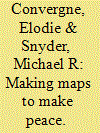

|
|
|
|
|
| Summary/Abstract |
This article analyses how United Nations peacekeeping operations are harnessing geospatial technology, including high-resolution satellite imagery and geographic information systems (GIS), in the furtherance of peace and security. We argue that it is strengthening the ability of peacekeepers to accomplish their mandated tasks, including the demarcation of international boundaries, support for the negotiation of peace agreements, stabilization, the protection of civilians, human rights monitoring, electoral assistance, support for the extension of state authority and the provision of humanitarian assistance. However, it remains to be seen how and to what extent UN peacekeeping can continue to grow and expand its geospatial capabilities. We identify several challenges of an operational and political nature that tend to impede its utilization. A key question in this regard is whether politics will prevent peacekeepers from exploiting recent advances in geospatial technology. We conclude and synthesize our argument by developing a simplified framework for determining when and under what conditions peacekeepers can effectively harness geospatial technology.
|
|
|
|
|
|
|
|
|
|
|
|
|
|
|
|
| 9 |
ID:
161556
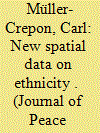

|
|
|
|
|
| Summary/Abstract |
Research on ethnic politics and political violence has benefited substantially from the growing availability of cross-national, geo-coded data on ethnic settlement patterns. However, because existing datasets represent ethnic homelands using aggregate polygon features, they lack information on ethnic compositions at the local level. Addressing this gap, this article introduces the Spatially Interpolated Data on Ethnicity (SIDE) dataset, a collection of 253 near-continuous maps of local ethno-linguistic, religious and ethno-religious settlement patterns in 47 low- and middle-income countries. We create these data using spatial interpolation and machine learning methods to generalize the ethnicity-related information in the geo-coded Demographic and Health Surveys (DHS). For each DHS survey we provide the ethnic, religious and ethno-religious compositions of cells on a raster that covers the respective countries at a resolution of 30 arc-seconds. The resulting data are optimized for use with geographic information systems (GIS) software. Comparisons of SIDE with existing categorical datasets and district-level census data from Uganda and Senegal are used to assess the data’s accuracy. Finally, we use the new data to study the effects of local polarization between politically relevant ethnic groups, finding a positive effect on the risk of local violence such as riots and protests. However, local ethno-political polarization is not statistically associated with violent events pertaining to larger-scale processes such as civil wars.
|
|
|
|
|
|
|
|
|
|
|
|
|
|
|
|
| 10 |
ID:
092732


|
|
|
|
|
| Publication |
2009.
|
| Summary/Abstract |
In this paper all provinces of South Africa with a good potential for the implementation of large-scale concentrating solar power plants are identified using geographic information systems. The areas are assumed suitable if they get sufficient sunshine, are close enough to transmission lines, are flat enough, their respective vegetation is not under threat and they have a suitable land use profile. Various maps are created showing the solar resource, the slope, areas with "least threatened" vegetation, proximity to transmission lines and areas suitable for the installation of large concentrating solar power plants. Assuming the installation of parabolic trough plants, it is found that the identified suitable areas could accommodate plants with a nominal capacity of 510.3 GW in the Northern Cape, 25.3 GW in the Free State, 10.5 GW in the Western Cape and 1.6 GW in the Eastern Cape, which gives a total potential nominal capacity of 547.6 GW for the whole country.
|
|
|
|
|
|
|
|
|
|
|
|
|
|
|
|
| 11 |
ID:
098417


|
|
|
|
|
| Publication |
2010.
|
| Summary/Abstract |
Whether qualitative or quantitative, contemporary civil-war studies have a tendency to over-aggregate empirical evidence. In order to open the black box of the state, it is necessary to pinpoint the location of key conflict parties. As a contribution to this task, this article describes a data project that geo-references ethnic groups around the world. Relying on maps and data drawn from the classical Soviet Atlas Narodov Mira (ANM), the 'Geo-referencing of ethnic groups' (GREG) dataset employs geographic information systems (GIS) to represent group territories as polygons. This article introduces the structure of the GREG dataset and gives an example for its application by examining the impact of group concentration on conflict. In line with previous findings, the authors show that groups with a single territorial cluster according to GREG have a significantly higher risk of conflict. This example demonstrates how the GREG dataset can be processed in the R statistical package without specific skills in GIS. The authors also provide a detailed discussion of the shortcomings of the GREG dataset, resulting from the datedness of the ANM and its unclear coding conventions. In comparing GREG to other datasets on ethnicity, the article makes an attempt to illustrate the strengths and weaknesses associated with the GREG database.
|
|
|
|
|
|
|
|
|
|
|
|
|
|
|
|
| 12 |
ID:
117212
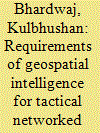

|
|
|
| 13 |
ID:
142046
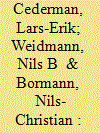

|
|
|
|
|
| Summary/Abstract |
Does economic inequality cause civil war? Deviating from individualist measures of inequality such as the Gini coefficient, recent studies have found a statistical link between group-level inequalities and conflict onset. Yet, this connection remains controversial, not least because of the difficulties associated with conceptualizing and measuring group-level differences in development. In an effort to overcome weaknesses afflicting specific methods of measurement, we introduce a new composite indicator that exploits the strengths of three sources of data. The first step of our method combines geocoded data from the G-Econ project with night lights emissions data from satellites. In a second step, we bring together the combined spatial values with survey estimates in order to arrive at an improved measure of group-level inequality that is both more accurate and more robust than any one of the component measures. We evaluate the effect of the combined indicator and its components on the onset of civil violence. As expected, the combined index yields stronger results as more information becomes available, thus confirming the initial hypothesis that horizontal economic inequality does drive conflict in the case of groups that are relatively poor compared to the country average. Furthermore, these findings appear to be considerably more robust than those relying on a single data source.
|
|
|
|
|
|
|
|
|
|
|
|
|
|
|
|
|
|
|
|
|